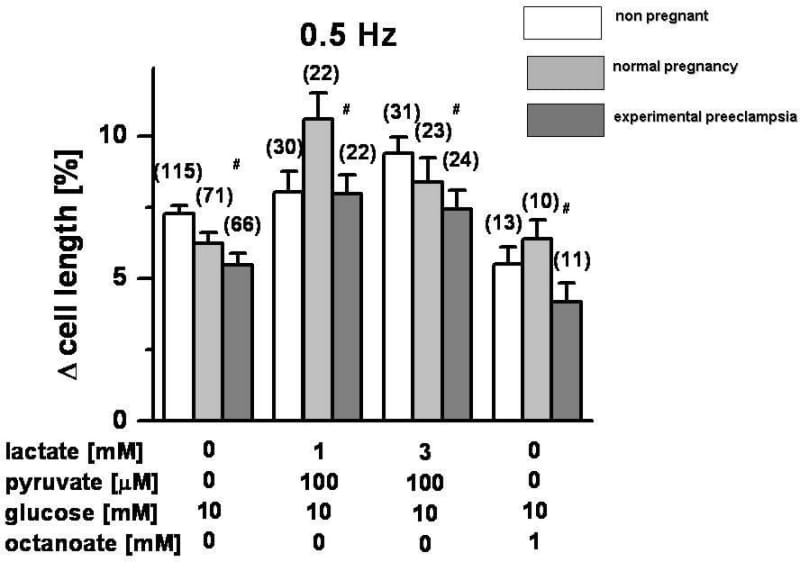Preeclampsia, a hypertensive disorder during pregnancy, is associated with important risks for maternal and perinatal morbidity and mortality. Notwithstanding, cardiac changes in this condition are still poorly understood. Significant modifications in carbohydrate metabolism are induced in pregnancy to provide continuous nutrients availability to the developing fetus, primarily depending on glucose. Our objective is to identify how metabolic changes, taking place during pregnancy, affect the cardiomyocyte function in late stages of normal pregnancy and of experimental preeclampsia induced by a high sodium intake (Auger et al. 2004). Two groups of Sprague-Dawley pregnant rats were studied. The first received tap water (P) and was compared with non-pregnant females (NP). The second received 0.9% NaCl to drink for the last 7 days of pregnancy (P0.9) and was compared with P. At the 21st day of pregnancy, rats were humanely killed, blood collected for metabolite assays and single left ventricular myocytes isolated. Contractility was assessed by confocal microscopy. Data are shown as mean ± S.E.M. (n). First, we compared blood levels of glucose, lactate and pyruvate (p<0.05 P vs NP and P0.9 vs P using a factorial ANOVA). In P, there was a significant decrease in glycaemia from 16.2 ± 0.8 mM (5) to 9.0 ± 1.4 mM (5), in accordance with glucose being used by the fetus. Significantly increased lactate levels led to a rise in the lactate/pyruvate ratio from 18.8 ± 1.8 (5) to 26.4 ± 1.9 (5), indicating redox state modifications. In P0.9, compared with P, neither levels of glucose, nor lactate and pyruvate were significantly different, but the lactate/pyruvate ratio failed to increase, remaining at 20.3 ± 1.4 (5). Second, cells were exposed, additionally to glucose, to blood levels of the carbohydrate substrates and/or octanoate, a medium chain fatty acid, and cell contractility was assessed. Figure 1 shows that in pregnancy (P and P0.9), contrary to NP, the addition of substrates significantly affected cell shortening (0.5 Hz, 35 ± 1°C) when compared to the condition with glucose only (p<0.05 vs P using a factorial ANOVA). In P0.9, the effect of lactate was blunted when compared to P. The pattern of the response was parallel when the experiments were performed at 6 Hz (not shown), suggesting that this phenomenon is not frequency dependant. Our data indicate that adaptations in the use of metabolic energy substrates occur in normal pregnancy and that this process is impaired in experimental preeclampsia.
University of Bristol (2005) J Physiol 567P, C124
Oral Communications: Metabolic substrates affect differently contractility of left ventricular cardiomyocytes in pregnancy and in experimental preeclampsia in rats
Bassien-Capsa, Valerie; Comte, Blandine; Chorvatova, Alzbeta;
1. Sainte Justine Hospital, Centre de recherche, Montreal, QC, Canada.
View other abstracts by:
Figure 1. Effect of substrates on cell shortening
Where applicable, experiments conform with Society ethical requirements.

